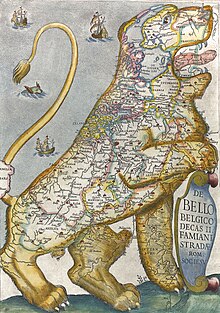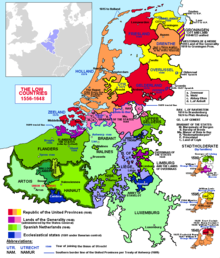
Back أصل تسمية هولندا Arabic Països Baixos (topònim) Catalan Holanda (topónimo) Spanish Pays-Bas (toponymie) French Benamingen van de Lage Landen Dutch Holanda (topônimo) Portuguese Țările de Jos (terminologie) Romanian Mga pangalan ng Olanda Tagalog


The Low Countries comprise the coastal Rhine–Meuse–Scheldt delta region in Western Europe, whose definition usually includes the modern countries of Luxembourg, Belgium and the Netherlands.[1][2] Both Belgium and the Netherlands derived their names from earlier names for the region, due to nether meaning "low" and Belgica being the Latinized name for all the Low Countries,[3] a nomenclature that became obsolete after Belgium's secession in 1830.
The Low Countries—and the Netherlands and Belgium—had in their history exceptionally many and widely varying names, resulting in equally varying names in different languages. There is diversity even within languages: the use of one word for the country and another for the adjective form is common. This holds for English, where Dutch is the adjective form for the country "the Netherlands". Moreover, many languages have the same word for both the country of the Netherlands and the region of the Low Countries, e.g., French (les Pays-Bas) and Spanish (los Países Bajos). The complicated nomenclature is a source of confusion for outsiders, and is due to the long history of the language, the culture and the frequent change of economic and military power within the Low Countries over the past 2,000 years.
- ^ "Low Countries". Encyclopædia Britannica. Encyclopædia Britannica, Inc. Archived from the original on 10 June 2015. Retrieved 26 January 2014.
- ^ "Low Countries - definition of Low Countries by the Free Online Dictionary, Thesaurus and Encyclopedia". Farlex, Inc. Archived from the original on 7 May 2019. Retrieved 26 January 2014.
- ^ derived from the ancient Belgae confederation of tribes.
© MMXXIII Rich X Search. We shall prevail. All rights reserved. Rich X Search